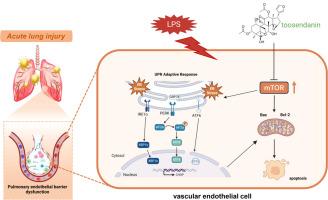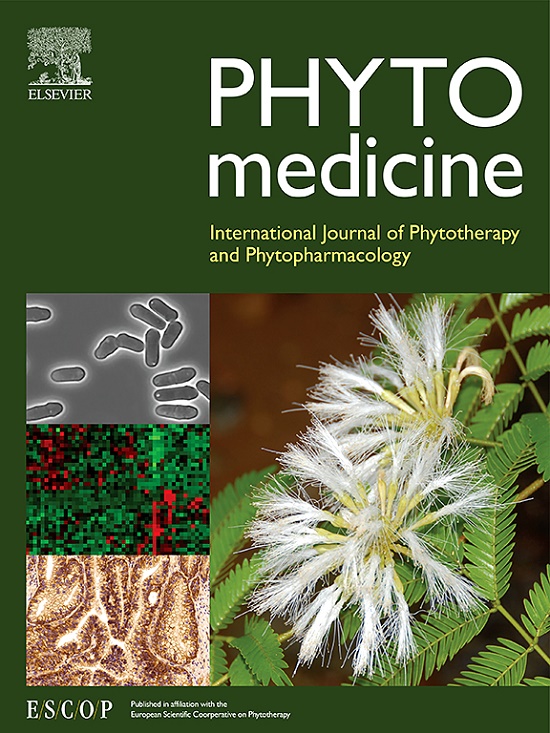Toosendanin alleviates acute lung injury by reducing pulmonary vascular barrier dysfunction mediated by endoplasmic reticulum stress through mTOR
IF 6.7
1区 医学
Q1 CHEMISTRY, MEDICINAL
引用次数: 0
Abstract
Background
Acute lung injury (ALI) and acute respiratory distress syndrome (ARDS) are severe clinical conditions with limited treatment options. Toosendanin (TSN), a triterpenoid compound with anti-inflammatory effects, has unclear efficacy in ALI.
Purpose
This study aimed to evaluate TSN's protective effects on ALI and the related mechanisms.
Methods
Lipopolysaccharide (LPS)-induced ALI models were developed in vivo and in vitro. Endothelial permeability was measured using Evans Blue dye; lipid reactive oxygen species (ROS) and apoptosis were assessed using flow cytometry. Malondialdehyde (MDA) and superoxide dismutase (SOD) levels were determined, and cell viability was measured. mRNA and protein expression were quantified using qRT-PCR and Western blotting. Network pharmacology and surface plasmon resonance were used to identify and validate TSN's targets.
Results
TSN reduced endothelial permeability and LPS-induced ALI. It lowered ROS levels, lipid peroxidation, endoplasmic reticulum (ER) stress, and apoptosis, both in vitro and in vivo. Network pharmacology identified mTOR as a key target of TSN, and surface plasmon resonance analysis confirmed TSN's direct binding to mTOR, underscoring mTOR's role in TSN's protective effects against ALI. Western blotting showed that TSN inhibits mTOR and its phosphorylation. In vitro, the mTOR activator MHY1485 reversed TSN's protective effects, increasing ER stress, apoptosis, and endothelial permeability. In vivo, TSN and rapamycin synergistically protected against ALI.
Conclusion
This study is the first to demonstrate that TSN protects against ALI by targeting the mTOR pathway, regulating ER stress and apoptosis and mitigating endothelial damage. These findings suggest a novel approach for ALI treatment and underscore TSN's potential clinical value.

仙丹素通过mTOR减轻内质网应激介导的肺血管屏障功能障碍,减轻急性肺损伤
急性肺损伤(ALI)和急性呼吸窘迫综合征(ARDS)是严重的临床疾病,治疗选择有限。仙丹素(TSN)是一种具有抗炎作用的三萜化合物,对ALI的疗效尚不清楚。目的探讨TSN对急性脑损伤的保护作用及其机制。方法建立脂多糖(LPS)诱导的ALI模型。采用Evans Blue染色法测定内皮细胞的通透性;流式细胞术检测脂质活性氧(ROS)和细胞凋亡。测定丙二醛(MDA)和超氧化物歧化酶(SOD)水平,并测定细胞活力。采用qRT-PCR和Western blotting检测mRNA和蛋白的表达。利用网络药理学和表面等离子体共振技术对TSN的靶点进行了识别和验证。结果stsn降低内皮通透性,减少脂多糖诱导的ALI。在体外和体内均可降低ROS水平、脂质过氧化、内质网应激和细胞凋亡。网络药理学鉴定mTOR是TSN的关键靶点,表面等离子体共振分析证实TSN与mTOR直接结合,强调了mTOR在TSN对ALI的保护作用中的作用。Western blotting显示TSN抑制mTOR及其磷酸化。在体外,mTOR激活剂MHY1485逆转了TSN的保护作用,增加内质网应激、细胞凋亡和内皮通透性。在体内,TSN和雷帕霉素具有协同保护作用。结论本研究首次证实TSN通过靶向mTOR通路,调节内质网应激和细胞凋亡,减轻内皮细胞损伤,对ALI具有保护作用。这些发现提示了一种治疗ALI的新方法,并强调了TSN的潜在临床价值。
本文章由计算机程序翻译,如有差异,请以英文原文为准。
求助全文
约1分钟内获得全文
求助全文
来源期刊

Phytomedicine
医学-药学
CiteScore
10.30
自引率
5.10%
发文量
670
审稿时长
91 days
期刊介绍:
Phytomedicine is a therapy-oriented journal that publishes innovative studies on the efficacy, safety, quality, and mechanisms of action of specified plant extracts, phytopharmaceuticals, and their isolated constituents. This includes clinical, pharmacological, pharmacokinetic, and toxicological studies of herbal medicinal products, preparations, and purified compounds with defined and consistent quality, ensuring reproducible pharmacological activity. Founded in 1994, Phytomedicine aims to focus and stimulate research in this field and establish internationally accepted scientific standards for pharmacological studies, proof of clinical efficacy, and safety of phytomedicines.
 求助内容:
求助内容: 应助结果提醒方式:
应助结果提醒方式:


